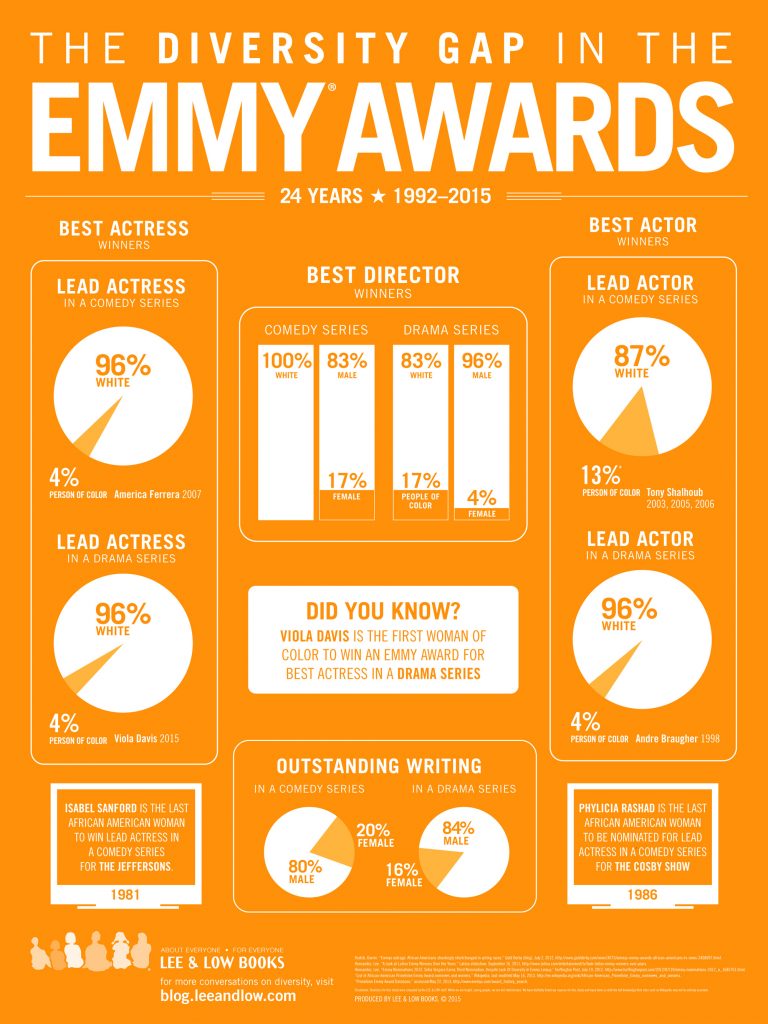Not only are we living in a Golden Age of television, it also feels in many ways like we are living in a Golden Age of diverse television. While TV may still be more segregated than we’d like it to be, both in front of and behind the camera, 2014-2015 saw the emergence of several critically and commercially successful shows with lead characters of color.
A few years ago, we published an infographic and study exploring the diversity gap in the Emmys and on television. Today we’ve updated that infographic and tried to answer the question: Has the Diversity Gap in Television decreased?
The Good:
Last night Viola Davis made Emmys history by becoming the first woman of color to win an Emmy Award for Lead Actress in a Drama Series!

Viola Davis accepts her Emmy Award.
In the most moving moment of the night, she directly addressed the discrimination that people of color face in Hollywood, saying:
The only thing that separates women of color from anyone else is opportunity. You cannot win an Emmy for roles that are simply not there.
The 2015 Emmy nominees were an exceptionally diverse crowd by Hollywood standards and happily Viola Davis was not the only talented person of color to go home with an Emmy in hand. Actors Regina King (Supporting Actress, Limited Series or Movie), Reg E. Cathey (Guest Actor, Drama), and Uzo Aduba (Best Supporting Actress, Drama) all went home with Emmys in hand. This also makes 2015 the first year that women of color won Emmys in the Drama category for both Best Lead Actress and Best Supporting Actress.

Uzo Aduba accepts her second Emmy Award (image from Hollywood Reporter).
Last night also saw several women honored in the directing category, an area usually dominated by men. Jill Soloway took home the Emmy for Best Director for a Comedy Series for Transparent, making her the third woman in a row to win this category. Lisa Cholodenko also took home a Directing Emmy for her work on the Limited Series Olive Kitteridge. In other words, two out of four Best Directing Emmys this year went to women.
The Bad
While last night saw some groundbreaking firsts, it’s not time for Hollywood to pat itself on the back just yet. Despite this year’s big win for Viola Davis, it’s important to remember that in the last 25 years, only one person of color has ever won in each of the four Lead Acting categories. There were no people of color nominated this year in the categories of Lead Actor in a Drama Series, Lead Actress in a Comedy Series or Supporting Actor in a Drama Series.
In addition, it’s worth noting that all of the people of color nominated in Acting categories this year were African American, with the exception of Louis C.K. (who is half Mexican). Asian, Latino, Middle Eastern, and Native actors still don’t have enough roles, leading or supporting, to be represented in any meaningful way at the Emmys. When Hollywood’s definition of “diversity” is reduced to Black or White, everyone still loses.
When it comes to gender representation, things are improving but some categories haven’t budged. 96% of winners in the Best Director of a Drama Series are still men, although one woman (Lesli Linka Glatter, Homeland) was at least nominated this year.
What Remains to Be Seen
It was clear this year that diversity was on people’s minds, and some big wins proved that it was on people’s ballots, too. But a good year, or even a few good years, are just a drop in the bucket when it comes to boosting opportunities and visibility of people of color and women in Hollywood. It may feel like progress is being made, but looking at our 2012 and 2015 infographics back to back, we can track whether that’s actually the case:

The Diversity Gap in the Emmy Awards, 2012
In some categories we do see improvement, but in most categories the percentage of winners who are people of color has actually decreased as the total number of years we track increases. While some people may dismiss this as a numbers game, it demonstrates an important point about diversity: it requires a conscious effort to change the status quo. If you do nothing, the numbers actually get worse.
Host Andy Samberg hit on this point in his opening monologue by congratulating Hollywood on such a diverse list of nominees:
The big story this year, of course, is diversity. This is the most diverse group of nominees in Emmy history, so congratulations Hollywood. You did it. Yeah, racism is over. Don’t fact check that.
Racism isn’t over and neither is sexism, but let’s hope that we’re moving into an age where both issues are treated by Hollywood as more than just a punchline.









